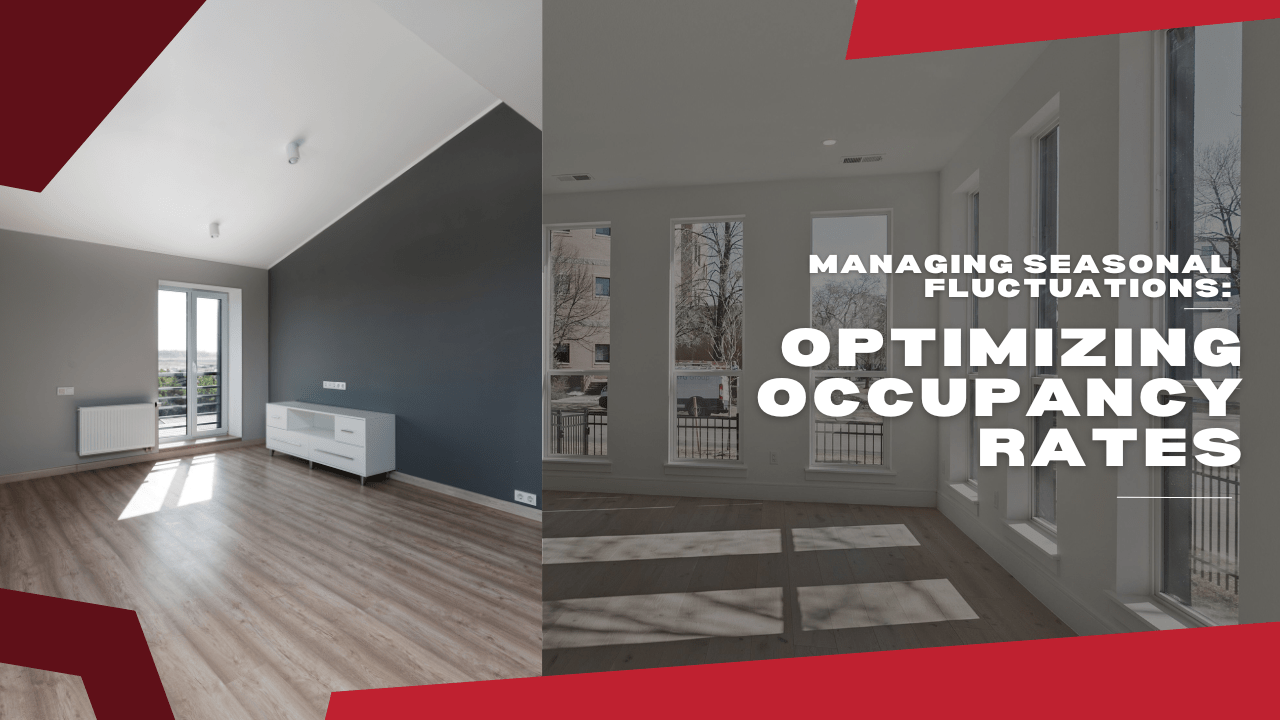
Long-term residential rental property owners are just as impacted by seasonal fluctuations as short-term or vacation owners. Even when it comes to those long residential leases, there is a seasonal factor to the rental market that impacts occupancy rates, pricing, and vacancy and turnover.
Demand is strong when it comes to rental homes in Santa Rosa and the surrounding areas, but understanding seasonal cycles can be an important part of your leasing, marketing, and renewal processes. When you work with our professional team, we not only understand these cycles, but we also manage your property proactively to optimize occupancy rates. In our experience, we have found that this can make a significant difference in your rental income and long-term investment strategy.
So, let’s explore the seasonal trends that impact rental occupancy in this unique market and offer practical strategies for managing these fluctuations. Whether you’re an experienced rental property owner or just starting your investment journey, these tips will help you maintain steady occupancy, minimize vacancies, and maximize rental income throughout the year.
Understanding the Seasonal Rental Market in Our Part of California
Like most rental markets, we operate seasonally, even if that shift is subtle. While we don’t have the dramatic temperature changes that other parts of the country do, we still experience distinct seasonal changes, which influence the rental market in different ways.
1. Spring and Summer (Peak Rental Season)
As property managers, we call this peak season because it’s often our busiest season. Here’s why.
- High Demand. The warmer months of spring and summer typically see a rise in rental demand. This period is especially attractive to renters who may want to settle into their homes before school begins in the fall. It’s a much easier time for tenants to move when they have children, and outside of a couple of holiday weekends, there are no extensive holidays on the calendar to impact plans. Prices are the highest in the spring and summer because homes are generally easier to rent.
- Leases Begin and End. Many rental leases are signed in the spring and summer, as renters seek stability before the academic year starts or during a transition in their lives. This is good news for owners who are signing a traditional 12-month lease. It means that if your tenants leave at the end of the lease term, they’ll be leaving during a busy rental market season, so replacing them won’t be much of a challenge.
- Higher Rent Prices. As we touched upon already, you can meet the higher end of your rental range in the spring and summer. With an increase in demand, landlords can often increase rent slightly during these months, which can improve profitability.
2. Fall and Winter (Off-Season)
Nothing lasts forever, including the days of easy renting. Things slow down a bit in the fall and summer. Here’s why.
- Lower Demand. Fall and winter typically see a dip in rental demand. The influx of new residents slows down as people settle in before the holidays. Renters may also be reluctant to move during colder or wetter months or around the holiday season.
- Lower Rent Prices. Due to decreased demand, landlords may have to lower rent slightly or offer incentives to keep properties occupied. Remaining competitive is essential when you want to avoid a longer vacancy.
- Shorter-Term Leases. Some renters may prefer to secure a lease for the winter months, but they may not commit long-term due to uncertainty about the spring or summer rental market. This can be tricky to navigate, so consult a property manager. While flexibility is good, you don’t want to make a mistake that might lead to less profitability.
Understanding these cycles is helpful in formulating an effective rental strategy. But how can you optimize occupancy rates during these seasonal fluctuations?
Adjusting Rent Prices Strategically
One of the most effective ways to manage seasonal fluctuations is by adjusting your rental prices to reflect market conditions. During the peak spring and summer months, when demand is higher, you can often raise rents to match the market rate without fear of losing tenants. When we’re talking about an occupied property that is subject to rent control laws, of course, you’ll need to be mindful of your legal limits when you’re raising the rent. Alternatively, during the fall and winter months, it might be wise to adjust rent prices to remain competitive.
Regularly check online rental platforms, local listings, and rental statistics to understand what similar properties in your area are charging. Be sure to monitor competitor properties’ vacancy rates, which can give you insight into the overall health of the local rental market. Research and knowledge can make the difference between a profitable rental price and one that good tenants refuse to pay.
During slower seasons, offering a temporary rent discount or incentive for longer-term leases can make your property more attractive to potential tenants.
Increasing Marketing Efforts During Off-Peak Months
Strategic marketing is always essential, but it becomes even more important during the off-peak months when demand is lower. By increasing your visibility and attracting more potential tenants, you can shorten vacancy periods and maintain a steady stream of income.
- Boost Your Online Presence. Platforms like Zillow, HotPads, Apartments.com, and local real estate websites are essential for marketing your property. Make sure your listings are detailed and highlight features that appeal to residents year-round.
- Invest in Professional Photography. High-quality photos that showcase your property in the best light can significantly improve your listing’s appeal. In the fall and winter months, ensure your property is staged to look cozy and inviting, with warm lighting and well-maintained interiors.
- Leverage Social Media. While those online rental platforms are great, social media allows you to expand your reach and engage directly with prospective residents.
Offer Flexible Lease Terms
One of the most effective ways to attract tenants during off-peak months is to offer flexible lease terms. While some renters may want the stability of a year-long lease, others may be hesitant to commit for that long, particularly during uncertain economic times or the holiday season.
- Short-Term Leases: Offering 6-month or 9-month leases can be attractive to renters who may only need temporary housing or are unsure of their long-term plans. This is especially useful in the winter months when families may not want to lock into a long lease before school ends or spring begins.
- Longer–Term Leases. Or, maybe you have tenants who want to sign an 18-month lease. This is good for you, too, because it means the lease will eventually end during a more competitive season, making it easier for you to rent the property at a higher rental rate.
- Month-to-Month Options: For renters who want more flexibility, offering month-to-month lease terms may be an appealing option. These leases allow tenants to stay for shorter periods, giving them flexibility if they plan to move soon or want to test the property before committing to a longer stay.
- Renewal Incentives: Offering incentives to tenants for renewing their lease early can help reduce vacancies in the future. This might include an upgrade to the property (new appliances or landscaping) to entice tenants to commit for another year.
Enhancing Property Appeal
While adjusting rent and marketing effectively are important, making sure your property stands out is a key component of maximizing occupancy during any season. The more appealing your property is, the more likely tenants will choose it over other options.
- Maintenance and Upgrades. Ensure that your property is in excellent condition year-round. Regular maintenance is essential, but it’s more than just repairs. Consider making upgrades that will enhance the tenant experience. Installing energy-efficient heating and cooling systems or providing insulation, for example, can attract tenants who value comfort and lower utility bills.
- Landscaping. Curb appeal matters, even in winter. Well-maintained landscaping with seasonal flowers or clean walkways can make a lasting impression. It’s particularly important during the rainy months to keep gutters and drainage systems clear to prevent water damage, which can deter potential renters.
- Pet-Friendly Policies. Many tenants are pet owners, so offering a pet-friendly policy can increase your pool of potential renters. Even if you don’t typically allow pets, offering an exception for well-behaved animals may make your property more attractive to a broader audience.
Create a Positive Tenant Experience
 The key to long-term success in renting out a home is creating a positive relationship with your tenants. Satisfied tenants are more likely to stay longer, which reduces vacancy and drives up rental income. Work with a property manager when you don’t have the time to invest in a positive tenant experience. Residents are looking for good communication, a lot of convenience, and reliability.
The key to long-term success in renting out a home is creating a positive relationship with your tenants. Satisfied tenants are more likely to stay longer, which reduces vacancy and drives up rental income. Work with a property manager when you don’t have the time to invest in a positive tenant experience. Residents are looking for good communication, a lot of convenience, and reliability.
Managing seasonal fluctuations in rental occupancy is an ongoing challenge for residential property owners in Santa Rosa and the surrounding areas. By understanding the market trends and strategically adjusting your pricing, marketing efforts, lease terms, and property appeal, you can optimize your occupancy rates and ensure your property remains a profitable investment.
We are good at keeping your rents consistent and climbing. If you need some help with managing seasonal trends and fluctuations, contact us at Redwood Residential Property Management.




 Graduate of Empire Business School, Santa Rosa in 1998 with an AA degree in Office Administration. Lorena has over 30 years of experience in office administration. From the California State Legislature to North Bay Realtors Association and most recently with Sue Carrell & Associates.
Graduate of Empire Business School, Santa Rosa in 1998 with an AA degree in Office Administration. Lorena has over 30 years of experience in office administration. From the California State Legislature to North Bay Realtors Association and most recently with Sue Carrell & Associates.